![]()
Skara Brae, a Neolithic village
![]()
Located in the Orkneys islands, archipelago in the North-West of Scotland, Skara Brae is a whole village of 10 houses , 5000 to 3500 years old , remained intact under the sand which covered it, until 1850 when a storm allowed its discovery. With the exception of the roofs, the structures were intact.
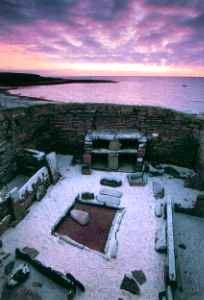 |
The reason is that all these dwellings were built out of stone. The founders, bold navigators who faced a hostile sea to reach this distant archipelago (and those who have took the" St Ola " to go from Thurso to Stromness, and underwent the large West swell which makes the ships roll can testify of the difficulty of the task ), where they settled as shepherds and fishermen. Wood being very rare on these stripped islands, it is in flagstones of schist, solids and easy to work , that they built their dwellings on the model of the wooden huts which they had on the continent. |
| This plate, on the site, shows us the village map. |  |
Below, one can see how the grass -dunes protect the site and for the anecdote, I would say that, during the maintenance work, where the mower cannot pass, the guards cut the rebellious strands of grass with the scissors...
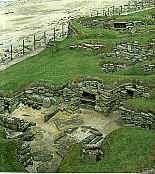 |
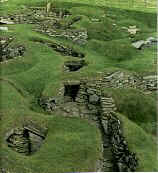 |
*** Stone Houses and pieces of furniture:
| The 10 houses of Skara Brae are joint or separated by walls of stones and connected between them by paved streets, there are also drains for water , gates of stone and even a small part which one could describe as bathroom! | 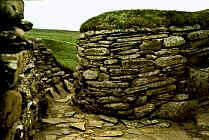 |
Most extraordinary on this site and also more moving is the furnishing of these houses which , as the walls , remained intact because made of stone:
** In the medium of the room of approximately 6 meters by 7, there is the hearth; often beside it, buckets made of 4 schist plates whose sealing was ensured by clay joints.
** Along the walls are beds, banks, dressers, cupboards containing stone axes and knives.
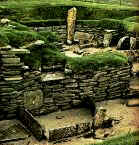 |
 |
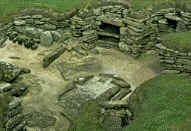 |
In ashes of the peat fires were found remains of cattlebone indicating these populations were stockbreeders and also undoubtedly fishermen: the houses were surrounded, so to speak " blocked up ", by accumulations of shells, fish-bones in addition to the bones of animals .
It seems that the inhabitants were constrained to leave the place precipitately as suggest a pearlnecklace left in a corridor or bones partially eaten close to a bed...
![]()
| Back to summary |  |
Next : Nuraghi in Sardinia |
| © Odile Prigent - Paleologos 1997-2004 | ||